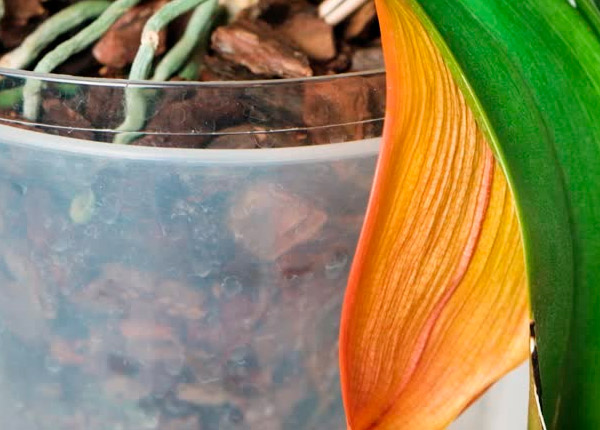Wilted orchid leaves
Last reviewed: 29.06.2025

Wilted leaves in orchids are a common issue that many growers face, leading to concern about the plant's health and vitality. If you've noticed wilted leaves on your orchid and are wondering what to do, this article will provide you with comprehensive information on possible causes and effective solutions. Understanding why orchid leaves become wilted is the first step towards helping your plant recover and thrive.
Why are my orchid leaves wilted?
Why do orchids have wilted leaves? There can be multiple reasons why orchid leaves become wilted and soft. It's important to identify the specific cause to take the correct action. Let's explore some of the common causes of wilted and wrinkled orchid leaves.
1. Improper watering
One of the most common reasons orchids have wilted leaves is improper watering. This could be either overwatering or underwatering:
- Overwatering: if orchid leaves are soft and wilted, it could indicate root rot due to overwatering. When roots are constantly submerged in water, they begin to decay, which prevents them from absorbing nutrients and water effectively. This leads to wilted leaves and roots in orchids.
- Underwatering: on the other hand, underwatering can also lead to wilted leaves. When orchids do not receive enough moisture, their roots dry out, and the leaves lose turgor pressure, becoming soft and wrinkled.
2. Root problems
Root health is crucial for the overall well-being of orchids. Wilted and wrinkled leaves can often be a sign of root damage. Healthy roots should be firm and green or white, while rotting roots will be brown and mushy. Wilted leaves and roots may indicate that the root system cannot support the plant.
3. Temperature stress
Temperature fluctuations or exposure to extreme temperatures can cause orchid leaves to become wilted. Orchids prefer stable conditions, and sudden changes in temperature—such as moving the plant near a draft or placing it in direct sunlight—can lead to soft and wilted leaves.
4. Low humidity
Orchids thrive in environments with moderate to high humidity. If the air is too dry, especially indoors during winter, orchids may suffer from wilted leaves. Maintaining proper humidity levels is key to avoiding soft and wilted orchid leaves.
5. Nutrient deficiencies
Nutrient deficiencies can also be a cause of wilted leaves in orchids. Orchids require balanced fertilization, and if they lack essential nutrients, they may exhibit signs of stress, such as wilted or soft leaves.

What to do if orchid leaves are wilted?
If you've noticed wilted leaves on your orchid, there are several steps you can take to help it recover. Here are some practical solutions depending on the cause of the problem.
1. Adjust watering practices
- Overwatering: if overwatering is the reason for the wilted leaves, it’s important to allow the orchid to dry out. Remove the plant from its pot, inspect the roots, and trim away any that are rotting. Repot the orchid in fresh, well-draining medium to prevent further issues.
- Underwatering: if the plant has wilted leaves due to underwatering, gradually increase watering. Soak the orchid in room-temperature water for about 15-20 minutes, allowing the roots to absorb moisture. Be sure not to overcompensate by overwatering, as this can lead to other problems.
2. Improve root health
Wilted leaves and roots often indicate root issues. Gently remove the orchid from its pot, rinse the roots, and trim away any dead or rotten sections. Repot the plant in a suitable medium, such as bark or sphagnum moss, that allows good air circulation.
3. Maintain stable temperature
Ensure that your orchid is kept in a location with stable temperatures between 18-24°c (65-75°f). Avoid placing it near drafts, heating vents, or direct sunlight, which can lead to temperature stress and wilted leaves.
4. Increase humidity
If humidity is low, consider placing a humidifier near your orchid or setting the pot on a tray with wet pebbles. This will help maintain the necessary moisture in the air and prevent soft, wilted leaves from developing.
5. Fertilize appropriately
Use a balanced orchid fertilizer to ensure that your plant receives all the essential nutrients. Fertilize every 2-4 weeks during the growing season and reduce feeding during winter. This will help avoid nutrient deficiencies that may cause wilted leaves.
Common scenarios: wilted orchid leaves
- Wilted leaves after repotting: it’s common for orchids to experience some stress after being repotted, which can result in wilted leaves. Ensure the plant is watered appropriately and kept in stable conditions to minimize stress.
- Lower leaves on orchid are wilted: sometimes, the lower leaves on an orchid may become wilted as part of the plant's natural aging process. If the upper leaves are healthy, there may be no cause for concern.
- Wilted leaves in orchid seedlings: if the leaves of an orchid seedling are wilted, it may indicate that the plant is not receiving adequate care, such as proper watering, humidity, or light.
Conclusion
Wilted leaves in orchids can be alarming, but with proper care and attention, most issues can be resolved. By understanding why orchid leaves become wilted and what to do in such situations, you can help your plant regain its health and vitality. Whether it’s due to improper watering, root problems, temperature stress, or nutrient deficiencies, taking the appropriate steps will ensure your orchid thrives.
If you’re experiencing wilted orchid leaves, take time to assess the plant's environment and care regimen. Making small adjustments can lead to significant improvements in the health and appearance of your beloved orchid.
